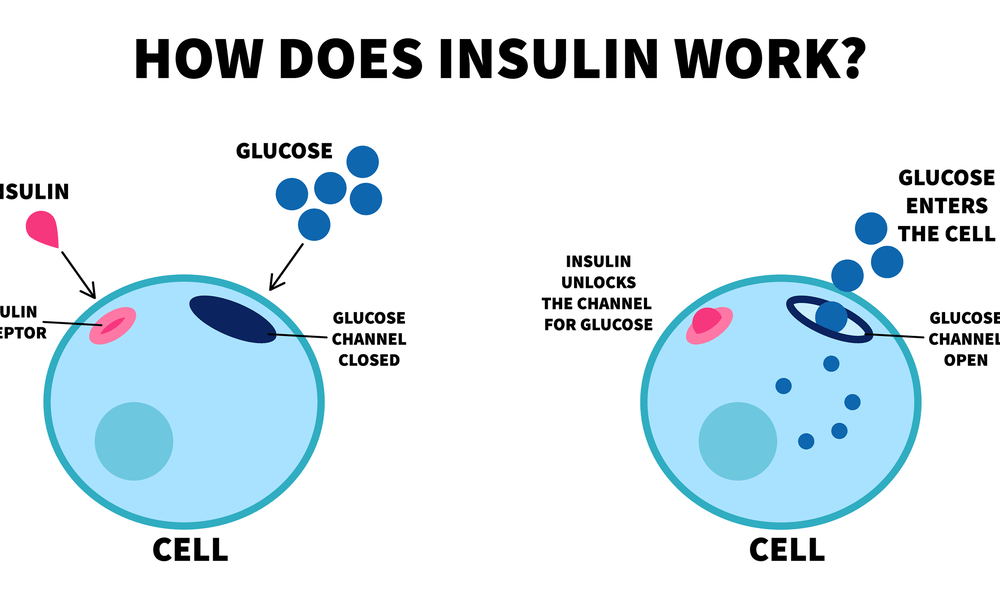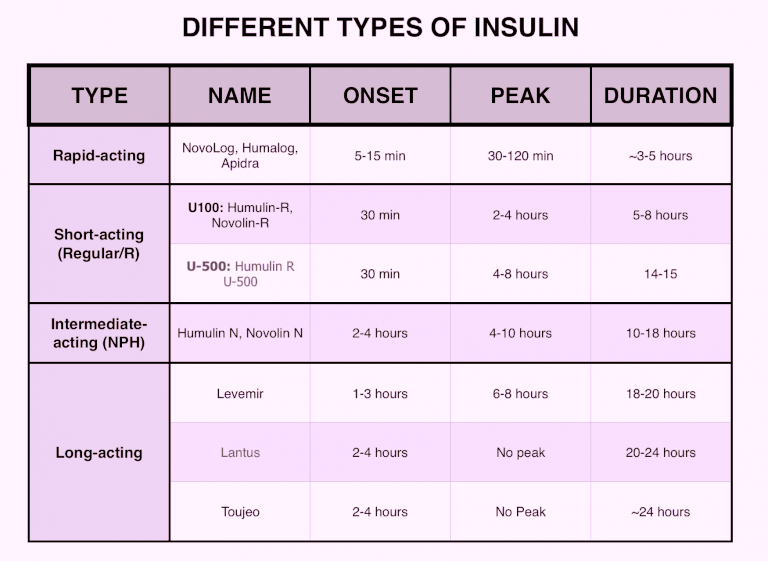Last updated on September 27th, 2022
Hormones are the molecules produced in the body. They are responsible for sending messages to different parts of the body. They instruct certain cells and tissues of the body to act in a certain manner. Consequently, it supports various functions in the body. Insulin is one of the hormones produced in the body. The pancreas is the body organ that is responsible for producing Insulin. Read this blog to know about “role of insulin and how does insulin work”

Role of Insulin in the Human Body

Insulin plays a number of important functions in the human body. It has its effects on functions including:
- Controls blood sugar level: Insulin is responsible for controlling blood glucose levels. When you eat food, the carbohydrate breaks into body glucose (sugar). This glucose then enters your bloodstream and increases your blood sugar level. Without the release of insulin, a person’s blood sugar level will either reach too high or drops too low.
- Regulate metabolic process: Insulin interacts with glucose. It enables the cells of your body to use glucose for energy. It signals your body to store an excess of glucose in your liver as glycogen. This glucose is used as energy at the time when your blood glucose level is low. Insulin helps in the synthesis of glycogen. Additional glucose is taken in to adipose tissue when the liver gets saturated with glycogen. It, therefore, leads to the synthesis of lipoproteins and regulates the metabolism of your body.
- Manage fluid volume in urine: Lack of insulin in your body prevents the excretion of sodium in the urine. This causes an increase in urine glucose level and frequent urination.
- Transport amino acid to muscle tissue: Uptake amino acids and potassium into the cells of your body. The absence of insulin does not support the transportation of amino acids and potassium. The transportation of amino acid to the muscle tissue helps in repairing muscle damage.
Also Read: Glycogen and Diabetes
Purpose of taking insulin
People with diabetes mellitus have the low ability to take and make use of glucose effectively. This led to an increase in the blood glucose level. Thus, it causes either type-1 or type-2 diabetes in a person. People can take insulin when other treatments are not able to keep their blood glucose level in a normal range. It helps in preventing complications due to diabetes including kidney damage.
Insulin for Treating Diabetes
A person suffers from either type-1 or type-2 diabetes in lack of insulin. Thus, a person’s body may not produce or use insulin properly. In such cases, the doctors prescribe man-made insulin to control the blood glucose levels. Injections of insulin can treat both type-1 and type-2 diabetes. It supplements the naturally produced insulin of your body.
- Insulin for type-1 diabetes: People suffering from type-1 diabetes do not produce insulin in the required amount. Therefore, they need insulin injections regularly to control their blood glucose levels. People with type-1 diabetes often need to inject insulin up to 4-5 times a day.
- Insulin for type-2 diabetes: The body of people with type-2 diabetes is not able to make use of the body’s insulin. Their body becomes resistant to the effects of insulin. It means their body needs more insulin to function like naturally produced insulin. However, they can maintain a certain level of blood glucose through lifestyle changes and certain medications. If they are unable to control their diabetes through these methods then they may need insulin injection.
- Insulin for gestational diabetes: A lot of women suffer from gestational diabetes during pregnancy due to hormonal imbalance. Gestational diabetes increases the risk of pregnancy. Therefore, pregnant women need to keep their gestational diabetes in control. Many pregnant women can easily keep their blood sugar levels in control through proper diet, exercise, and oral diabetes medicines. However, some women may need insulin to keep their diabetes in control.
Also Read: Blood Sugar Lowering Tips

Categories of Insulin
Insulins are classified into the following categories based on their differences:
- Onset: It is the time that insulin takes to show impact
- Peak: It is the time when the insulin is most effective
- Duration: It shows the period of effectiveness of insulin on a person.
- Route of delivery: There are different methods of taking insulin. Route of delivery is the method of choice for insulin intake. You can take it either intravenously or inject.
Types of Man Made Insulin

There are mainly following types of Insulin:
- Rapid-acting Insulin: This type of insulin starts its work immediately after 15 minutes of injection. Its peak is of 30-90 minutes. It is effective for 2-4 hours. You may inject rapid-acting insulin right before the meal. This insulin acts quickly. Therefore, you should eat right after taking this insulin. It reduces the risk of low blood sugar.
- Short-acting Insulin: You can inject such insulins before taking a meal. It normally starts working after 30-60 minutes of injection. It works longer than rapid-acting insulin. Its effect can last between 6-8 hours.
- Intermediate-acting Insulin: These insulins have lasting effects up to 12 hours. It shows its effect at least after 2 hours of injection. Your doctor may recommend intermediate-acting insulin to cover your overnight insulin requirements.
- Long-lasting Insulin: Long-lasting insulins cover up your need for all-day insulin. You will need to inject it once a day to keep your blood sugar levels in control. You can inject it either in the morning or before bed to maintain insulin levels in your body.
- Inhaled insulin: It is a kind of rapid-acting insulin. You need to inhale such insulins. You can use the combination of inhaled insulin with long-lasting insulin. However, cannot replace its need.
Devices for Taking Insulin
There are different types of insulin delivery devices. You can discuss with your doctor to choose the most suitable insulin delivery device for you. The three devices for taking insulin are as follows:
- Insulin syringes: Syringes are the most common insulin delivery devices. It is used to Inject Insulin into the fatty tissue under your skin. Insulin syringes are for single use. They are available in different sizes. Syringes are available in 30-unit (0.3 ml), 50-unit (0.5 ml) and 100-unit (1.0 ml) measures. You can choose the syringe depending on your insulin dose. Different sizes of needles are also available according to the size of the syringe.
- Insulin pens: Insulin Pens are trending these days. These pens allow simple, convenient, and accurate delivery of insulin. There are disposable and usable insulin pens for injecting insulin. A disposable pen contains prefilled insulin cartridge. You need to dispose of the pen after a single-use. A reusable insulin pen contains a reusable insulin cartridge. You can install a new cartridge to replace the empty cartridge.
- Insulin pumps: These are small-sized computerized devices. They deliver small doses of short-acting insulin to your body continuously. An insulin pump can be worn around your waist with the help of a belt. It delivers insulin with the help of a tube connected to a thin cannula. There are built-in calculators in these pumps. Hence, it makes it easier to calculate your insulin dose on the basis of your blood sugar.
Getting Started on Insulin
Taking insulin is now easier and more convenient. When a doctor prescribes you to take insulin for managing diabetes, you should learn about its administration and dosage. It will help you to take the insulin shots at the right time and in the right dosage.
Insulin Dosage: Insulin dose varies from person to person. Its dosage depends upon a person’s blood glucose level and diabetes management goals. A person’s physical activities, diet, and seriousness of diabetes decide his required amount of insulin dose. People with diabetes type-2 may need one or two insulin shots per day. Others may need three or four shots to maintain the normal blood insulin levels.
Insulin Injection Site: You cannot take insulin through the mouth. You can inject under the skin at thighs, buttocks, abdomen, and upper arms. Avoid injecting insulin around two inches of your belly button. At this site, your body will not absorb insulin.
Essentials to Give Yourself Insulin:
- Ensure you have the following supplies:
- Soap and water
- Insulin vial
- Insulin syringe/ insulin pen
- Sharp container for disposing of the needle
- Wash your hands properly.
- Clean the top of the vial with cotton dipped in alcohol.
- Draw the insulin dose amount into the syringe and ensure there is no air bubble.
- If you are using an insulin pen, firstly attach a needle to the end of the pen. Give the air shot to make sure the pen is working. Dial up the insulin dose.
- Pinch the small portion of your skin before inserting it into the skin.
- Now, you need to hold the syringe or insulin pen at an angle of 90 degrees over the injecting site.
- Push the needle into the upper fatty layer of the skin.
- Press the plunger of a syringe or press the button on the insulin pen to get your dose.
- Finally, dispose of the used needle in the sharp container.
Storage of Insulin
It is important to store the insulin correctly. Very high or too low temperature can damage the insulin. Hence, it will not work effectively and may give you some side effects also.
- Always store the unopened insulin in the refrigerator
- The temperature of a refrigerator should be between 2 and 8 degrees Celsius
- Make sure that insulin does not freeze
- Avoid keeping insulin in direct sunlight
- Keep the opened insulin under room temperature
- Do not store the opened insulin for more than a month
- Use insulated bags for storing insulin while traveling
Also Read: Reverse Diabetes Naturally
Tips for Insulin Injection
Some tips for insulin injections are:
- Take care of the storage of insulin.
- Do not inject the insulin at the same site. It results in the thickening of the skin. Insulin absorption rate will also get reduced on injecting at the same site.
- Keep track of your blood sugar levels. It ensures proper diabetes management
- If you experience any side effects of insulin intake, carry at least 15 grams of quick-acting carbohydrates. These may include non-diet soda, fruit juice, candies, raisins, etc.
Summary:
Insulin is an essential hormone produced naturally in the human body. It allows cells and tissues to control the absorption of blood glucose and energy. It also helps in the breakdown of proteins and fats. There is no production and proper usage of insulin in people with diabetes type-1 and type-2 respectively. Therefore, people take insulin injections or oral medicines to counteract the effects of insulin resistance.
FAQ’s:
What are the reasons for the delay in insulin absorption?
Is Insulin safe during pregnancy or breastfeeding?
Women with gestational diabetes are recommended to control their blood sugar levels through exercises, diet, and lifestyle changes. If these don’t work, insulin injections are recommended by doctors. It is safe during pregnancy and breastfeeding.
Does a person have to take insulin forever?
People with diabetes type-2 and gestational diabetes have to take insulin for short-time duration. On the other hand, people with type-1 diabetes or kids having diabetes from birth will need insulin for a lifetime.
Is there any side effect of Insulin injections?
Low blood sugar level or hypoglycemia is the most common side effect of Insulin therapy. You may experience fatigue, numbness around your mouth, blurred vision, cold temperature, perspiration, etc. on lowering of your blood sugar level than the normal range.
Are Insulin injections mandatory for every person with diabetes?
Generally, insulin injection is mandatory for people with type-1 diabetes. However, there are many people with diabetes type-2 who may need Insulin injections for diabetes control.
Reference:
- https://www.medicalnewstoday.com/articles/323760
- https://www.healthline.com/health/type-2-diabetes/insulin#administration
- https://www.news-medical.net/health/Insulins-role-in-the-human-body.aspx
- https://www.goodrx.com/blog/insulin-types-how-to-use/
- https://www.betterhealth.vic.gov.au/health/conditionsandtreatments/diabetes-and-insulin#types-of-insulin
- https://www.webmd.com/diabetes/features/diabetes-injections-daily-life
Disclaimer
This site provides educational content; however, it is not a substitute for professional medical guidance. Readers should consult their healthcare professional for personalised guidance. We work hard to provide accurate and helpful information. Your well-being is important to us, and we value your feedback. To learn more, visit our editorial policy page for details on our content guidelines and the content creation process.

 English
English










